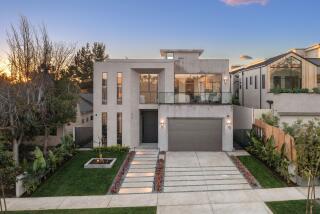Judge the Aftereffects . . . : . . . Before Remodeling
Westminster builder Dennis DâAmbra likes to point out that nobody ever said a blueprint was worth a thousand words.
Yet, for generations, anyone planning to build or remodel a house has had to rely on blueprints as a primary indicator of what the finished project was going to look like.
The problem, DâAmbra believes, is that many homeowners donât know how to read blueprints. âTheyâll tell me, âI saw the blueprint, but it confused me,â â says DâAmbra, 47, president of DâAmbra Inc. âOr theyâll say, âThatâs not what I thought it would look like.â The result is that we sometimes have to tear out a wall or practically start all over again. That can take a lot of time.â
By chance, DâAmbra made a discovery several months ago that is changing the way people look at remodeling--literally. He read a newspaper advertisement placed by a landscaping firm that used computer imaging to show potential clients what specific trees or shrubs would look like around their homes or offices.
âA light bulb went on in my head,â DâAmbra said. âI thought, if computer imaging can be used as a âbefore-and-afterâ tool for landscaping, why canât we do it in home remodeling?â
The result is that DâAmbraâs firm can show clients exactly what their home will look like after remodeling. The blueprints are still used by the people at the job site, of course, but the customer sees either a video or a still picture before any work is done.
âIt eliminates trial and error,â DâAmbra said. âAnd it eliminates questions and misunderstanding. Nothing is left to the imagination.â
After first realizing that computer imaging could be useful in remodeling, DâAmbra and his son, Chris, 21, went to Canoga Park, where they met with officials of New Image Industries, which manufactures computer imaging software for other applications. In addition to landscaping projections, computer imaging has been used to show would-be dieters what theyâll look like after dropping a few pounds and by plastic surgeons whose patients are eager to see what a face-lift or eyelid tuck would do for them. New Image also manufactures the hardware for the system.
The system that New Image designed for DâAmbra allows Chris, now officially the construction firmâs âimage designer,â to incorporate a virtually infinite number of roof-lines, door styles, driveways and other features into the image of a clientâs house.
It didnât come cheaply. DâAmbra estimates that he paid more than $35,000 for the package.
The results have been âdramatic,â he said. âWe keep putting new styles of homes into the database,â he says, âand people can choose any feature they want and see what it would look like on their house.â The charge to the client is about $100, applicable to any job the client might order from the firm.
âSomeone may say, âI liked a roof-line I saw at a place in Laguna Hills,â â DâAmbra says. Or they might like the roof from one place, the window treatment from a second and the driveway from a third. Want a bay window moved around? Like to see a double door?
âIf itâs in our database,â DâAmbra says, âChris can take the photo of their house, along with what theyâve said they want, and show them what theyâre looking for almost instantly. If it isnât, if they can give him a picture of what they want, within an hour to a day, he can show them what they had in mind, but on their house.
âHe can put a (Lamborghini) Countache in your driveway if youâd like, but we donât include the car with the deal.â
Similarly, a client can see what the newly remodeled family home would look like in virtually any color. âYou want yellow?â DâAmbra asks. âWe can call up every shade of yellow. If you prefer a beige, youâve got it. The system stores more than 32,000 colors. Want to see what the house will look like early in the morning or late in the afternoon? We can change the time of day or the angle of the shadow.â
Clients who want to see a video, rather than a still picture, of the proposed project get something even more exotic. The image, of course, starts when one of DâAmbraâs sales employees goes to the clientâs home and shoots the âbeforeâ video. âIf neighbors are walking by when weâre shooting the video,â DâAmbra says, âor a kid on a skateboard races past, theyâre going to show up on the âafterâ video too, moving past a house that doesnât even exist yet in that form.â
When working, Chris DâAmbra sits at a high-tech console surrounded by vinyl folders labeled âwindows and doors,â âexterior finishes,â âroofs, fireplaces and brick,â ânew homesâ and âdriveways and steps.â Cars and people can easily be superimposed on the property, he points out, jokingly placing a likeness of former President Ronald Reagan on the front walkway of a Whittier home (âPresident Richard Nixon is not in our database,â Dennis says).
The new system has been especially helpful for clients who have no special features in mind, DâAmbra says. And there are a few clients like that. âPeople will come to us and say, âI donât know what I want. Youâre the builder. You come up with an idea,â â he says. âOthers want their house to look like (Donald) Trumpâs Taj Mahal.â
DâAmbra Inc. has been in Westminster since the senior DâAmbra and his wife founded it in 1967--âwhen you could start with next to nothing,â he adds. âYou canât do that today.â He has always fancied himself a âhigh-tech thinker,â and the computer imaging equipment, he believes, makes his the only remodeling firm in Southern California with such a system.
Since he started using computer imaging late last year, his firm has completed 50 to 60 jobs--everything from simple room additions to cases in which, he says, âsomeone doesnât want to move and wants to spend $100,000 to make his house look like a $700,000 place down the block.â About 80% of his work consists of second-floor additions.
Surprisingly, only about 30% of his clients have asked to use the computer imaging equipment, probably because many of them already know what they want.
Since the system is unique to the area, DâAmbra allows other builders--many of them his competitors--to use it, for a price. âWhy not?â he asks. âThereâs nothing cloak-and-dagger about it. If everyone can benefit, thereâs no reason to keep it from them. This has given us a lot of exposure within the industry. We get a lot of calls.â
DâAmbra handles about 100 projects a year, all within a 20- to 25-mile radius from his office, âbut at least 80% in Huntington Beach and Fountain Valley, because thatâs where weâre known. What weâre doing is taking little houses and putting houses on top of them. Weâre bringing 1960s houses into the 1990s,â he says.
Apparently, his computer-generated photos are as realistic as they need to be. DâAmbra recently sought a zoning variance for a client from the Westminster Planning Commission. The man wanted a special garage built to house his boat. With a briefcase full of blueprints and a computer picture showing what he proposed to do, DâAmbra approached an inspector. âHe looked at it,â DâAmbra said, âand asked why we would want a variance for something that had already been built. He gave us the variance.â
More to Read
Inside the business of entertainment
The Wide Shot brings you news, analysis and insights on everything from streaming wars to production â and what it all means for the future.
You may occasionally receive promotional content from the Los Angeles Times.










